Las Totally Awesome Oxygen Orange Base Cleaner Review

I don't think there'southward any sports technology GPS sentinel startup that's being watched every bit closely by GPS watch industry giants as COROS is. Now as you'll run into, it may not be entirely for the reasons you think, only no matter the reason – they are definitely beingness watched.
COROS beginning arrived on my radar a few years back with their COROS Linx helmet, which used jawbone conduction to let you listen to music while riding without blocking out ambient street/car noise. It was cracking, and well executed. It also became my day to day helmet. They went onto release a few more variants of that helmet over the final couple of years.
So a year ago they appear the COROS Step GPS spotter, a full-blown multisport GPS watch. It was effectively a bones triathlon watch that was more or less a duplicate of the Garmin Forerunner 735XT in terms of looks and many bones features. Despite its somewhat bones software, information technology actually threw down actually impressive GPS performance and strong optical centre rate performance. In many cases besting Garmin, Suunto, and Polar in my tests.
Skip down the route to this by Nov, and COROS announced their Noon lineup. These watches did away with the plastic expect of the COROS Pace units, and instead looked a bit like a blend between a Garmin Fenix 5 and a Polar Vantage, with a side of Apple tree digital crown. Bated from the physical aspects, the visitor also added in additional training load related performance tracking software features. The price for all of this ended up being $299 – quite impressive.
Of course, the most basic question in many people's minds is: Is information technology any good?
Well, it'southward a complicated reply.
With the previous COROS Pace watches it was slightly more black and white, just with the APEX in that location's a lot of grayness. Not fifty'south shades worth, simply, enough that nuances is important.
In whatsoever case – we'll swoop into all those details down beneath. Notation that COROS sent over a few APEX media loaner units to test out (one of each size), and after this review I'll stick them in a box and ship them back. After which I'll go out and pick up any units I desire via normal retail channels. Just the way I roll. If you find this review useful, hit upwardly the links at the end of the post to back up the site.
What's in the box:
There are two versions of the COROS Noon watch, a 42mm and a 46mm. Inside that, in that location are a few color variants. The master differences between the 42mm and the 46mm are the case materials and battery life.
The 46mm gets upwards to 35hrs in regular GPS style (and 100 in UltraMax GPS mode) – $349
The 42mm gets upwardly to 25hrs in regular GPS mode (and lxxx in UltraMax GPS manner) – $299
Meanwhile, on the materials forepart, the 46mm uses a titanium blend bezel, while the 42mm uses a ceramic bezel. Both are waterproof to 100m and both have full barometric altimeters.
In any instance, I tested two variants. I tested a white 42mm as my primary picket, and so I as well had a black 46mm variant that I double-checked some stuff on, including one workout where I wore one of each watches (more on that in the accuracy section).
Hither'due south the outer box:
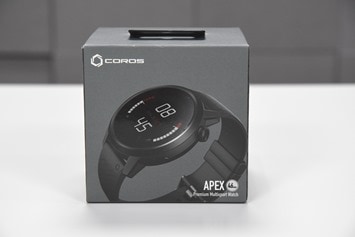
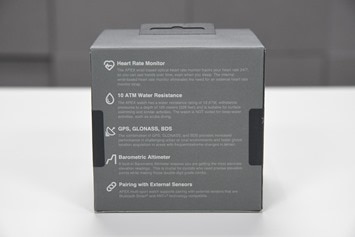
Next, one time we crack open the box we've got 3 things within: The watch, the cablevision, and the manual gear up.
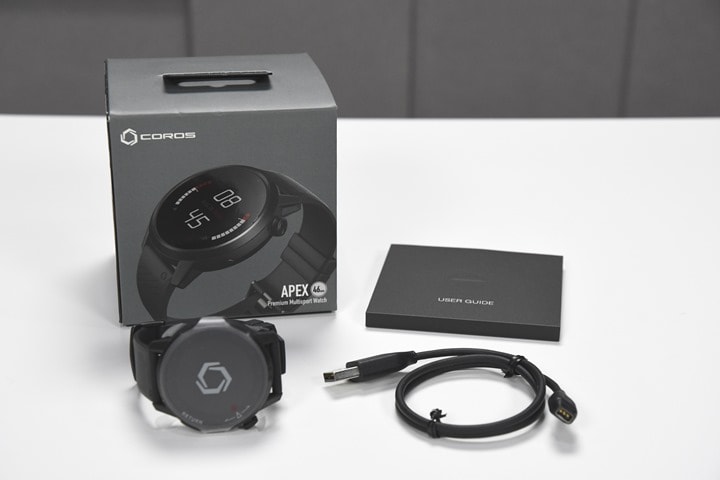
The sentinel has a groovy fiddling bit of plastic protecting it. I always capeesh companies practicing prophylactic shipping.
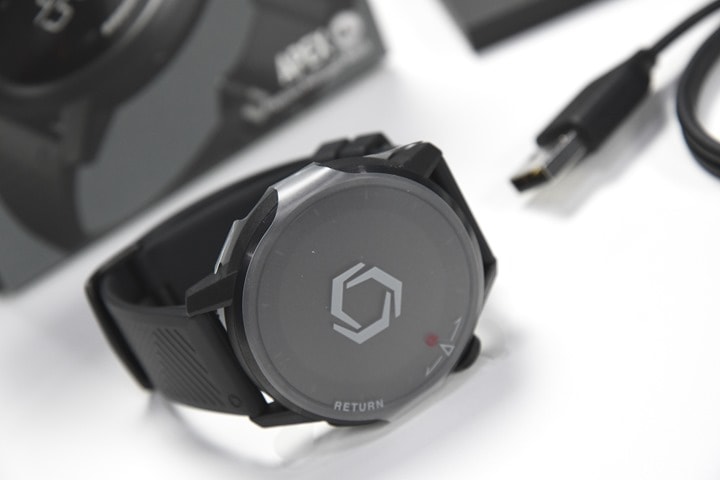
Meanwhile, the cable is a three-pronged affair that charges merely. Yous cannot download files from it via USB, equally download can only happen via the mobile app.
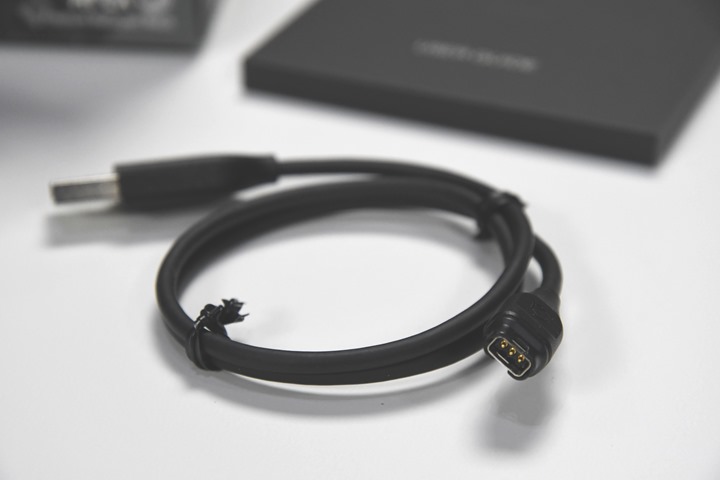
Then at that place'southward the user guide. You won't need it after this post.
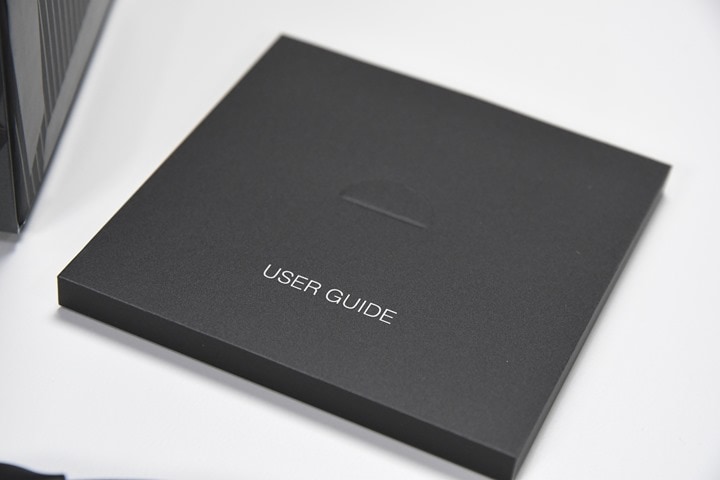
And…that's it. A quick and tidy look at stuff. Fearfulness non – you'll get plenty of pics of the watch throughout this review.
Oh, but because I don't take all the units, here's a quick cheat canvas that COROS has to the sizes, straps, and colors:

Ok, at present it's onto the main review.
The Nuts:
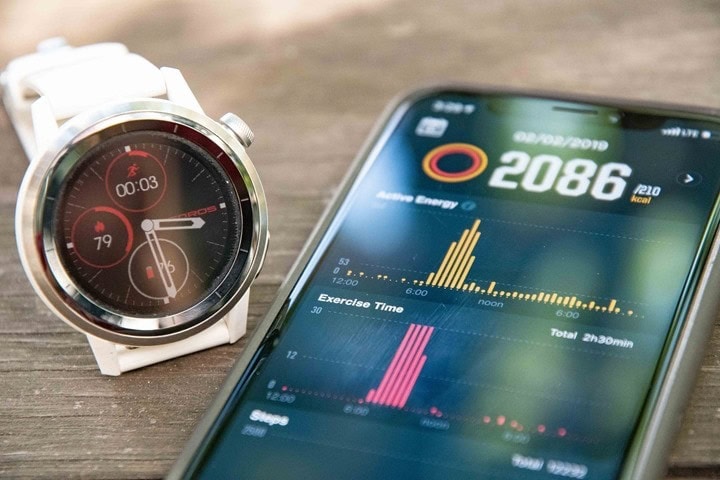
From a basics standpoint, no matter which sentinel you lot've selected, everything is the same. To start, the scout is *non* a touchscreen picket, which is practiced. I rarely discover touchscreens work out well for endurance sports watches. Instead, you have a mere two and a half buttons. Y'all've got one dedicated pressable push button in the lower correct, followed by one digital crown in the upper correct.
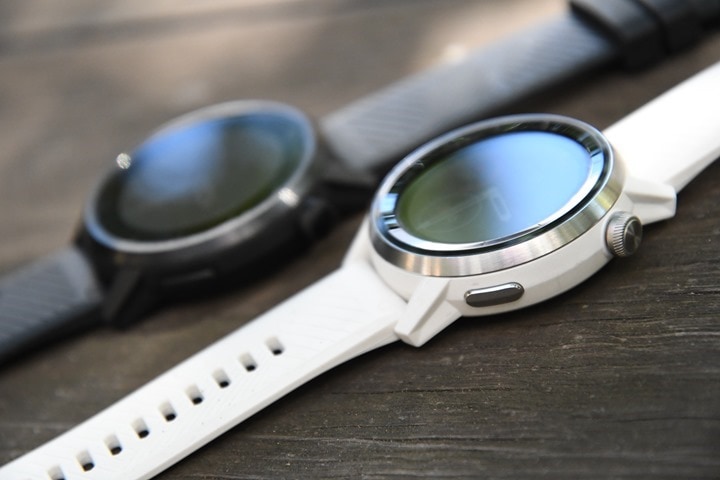
The digital crown can be rotated to whorl through menus and pages, while it besides serves equally a secondary button when pressed in. COROS has basically duplicated the push layout of an Apple Watch here…except without the requisite touchscreen.
Meanwhile, the strap is detachable. For the 46mm variant it has a 22mm strap, whereas the 42mm lookout man has a 20mm strap. It uses standard watch straps, and so you tin can mix and match based on whatever you find on Amazon.
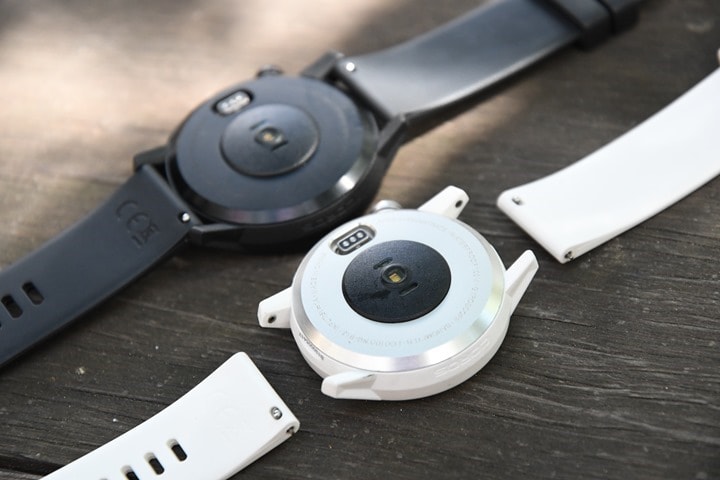
On the default watch confront you've got a about identical duplication of the Garmin Fenix serial (at correct) lookout face, making it an easy transition for those coming from Garmin.
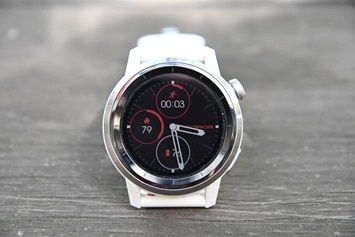

Don't worry though, if you're trying to motility away from the Garmin ecosystem you can alter these inside the app to not-Garmin watch faces if you prefer:
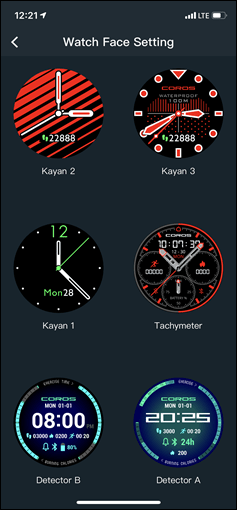
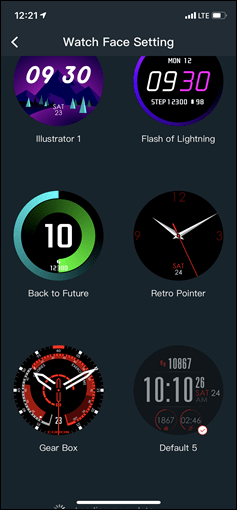
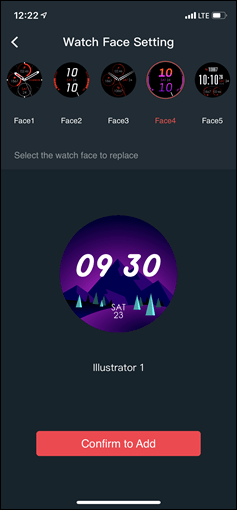
On the backside of the unit is both the optical HR sensor besides as the charging port:
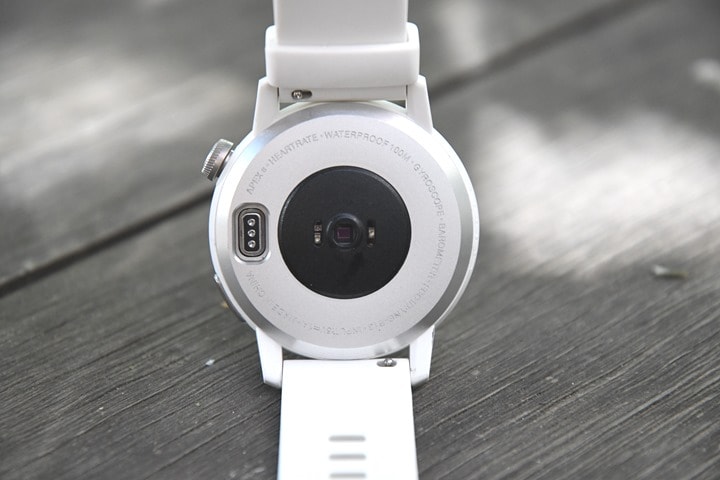
Next, you tin can ringlet through various widget screens, which include bones metrics like stairs and calories:
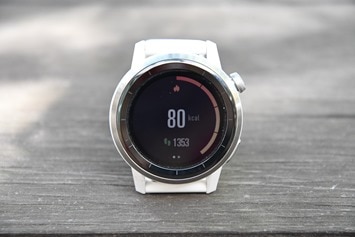
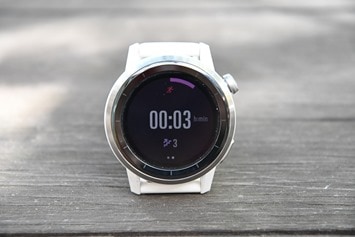
Or 24×7 eye charge per unit, and pressing the digital crown push button will take yous to the instant Hr screen:
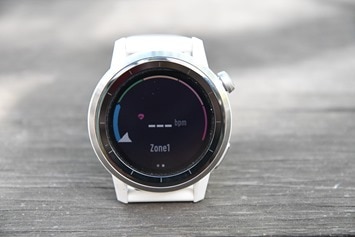
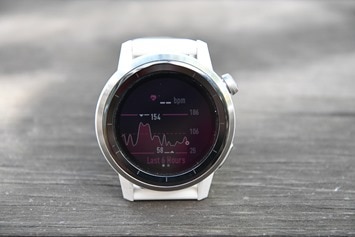
Scrolling once again takes yous to a threesome of a choice showing pressure level, altitude, and temperature over the by 6 hours:

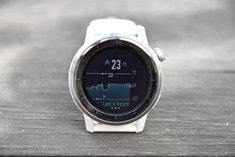
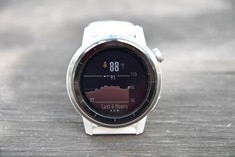
One more than whorl and you're down to the compass and GPS indicate strength:
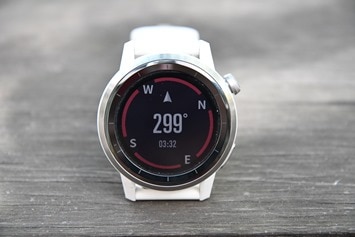
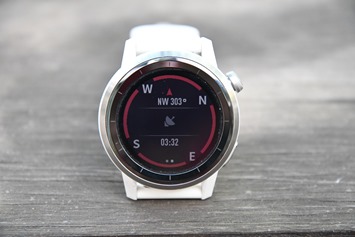
And finally, one last scroll and y'all're into the smartphone notifications console:

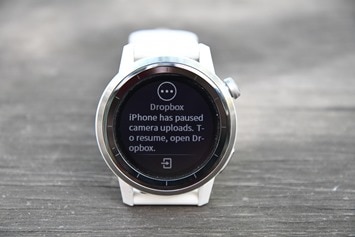
When it comes to daily metrics like steps or such, all of those are also viewable on the smartphone app. That epitome to the lower right is a near exact duplication of Apple's famed circular action chart:

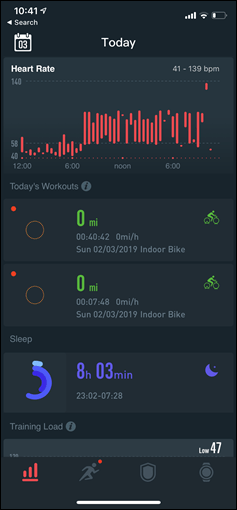
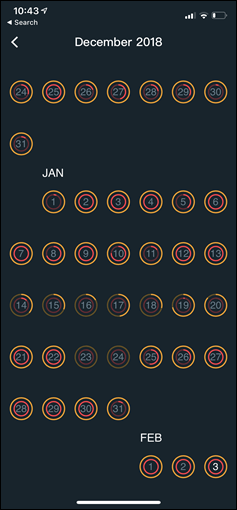
You tin can't view trends over longer periods of time beyond what's shown above, nor is there any website that things are sent to for review. Meaning everything is contained within the app. Though, as discussed after, some metrics can be transmitted to Apple Health on iOS, too as other 3rd party services like Strava.
If you want to tweak settings you can exercise then from inside the app for many things, such as backlight options, practise not disturb periods, and smartphone notification settings:
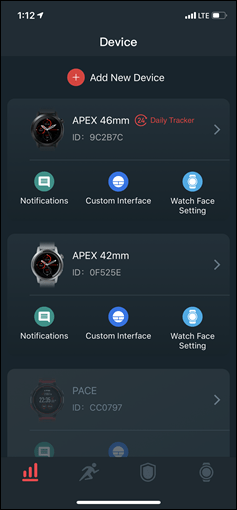
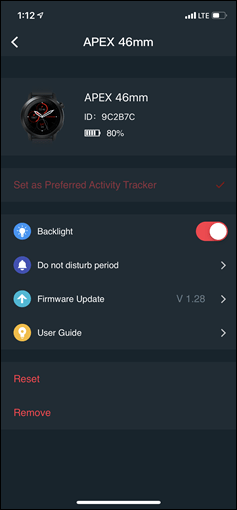
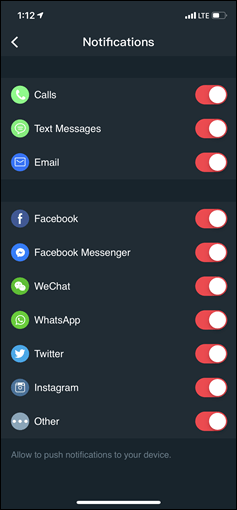
Interestingly, information technology allows you lot to toggle sure types of notifications – actualization to get those from the standard iOS (in my case) notifications middle. Ones not listed here still come through as expected. For case, I use Nest Cams and those notifications come through as expected despite not being on the listing to a higher place.
Finally, the last feature you've got is a page of your accomplishments, including 'medals' or badges that y'all've unlocked, equally well as total fourth dimension. Note that if you're using an indoor trainer and haven't paired the speed side of the equation over, these numbers will be rather low in winter (like mine are for cycling).
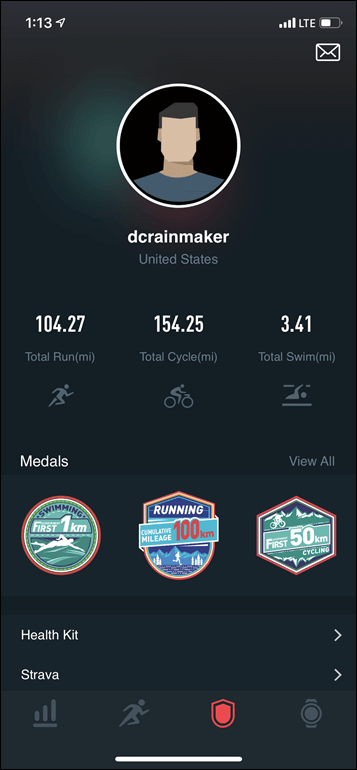
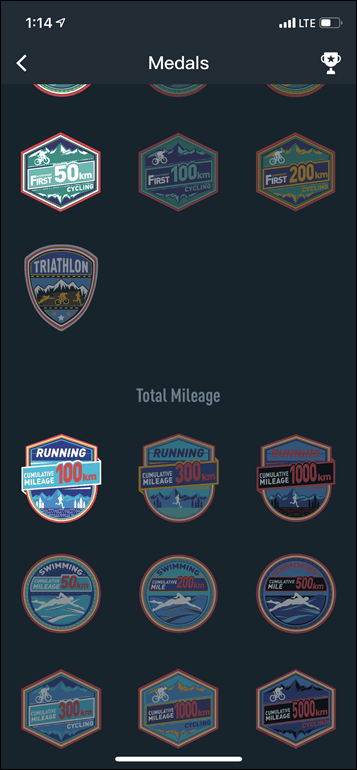
With that – permit's switch over to the fettle side of the house.
Sport Usage:
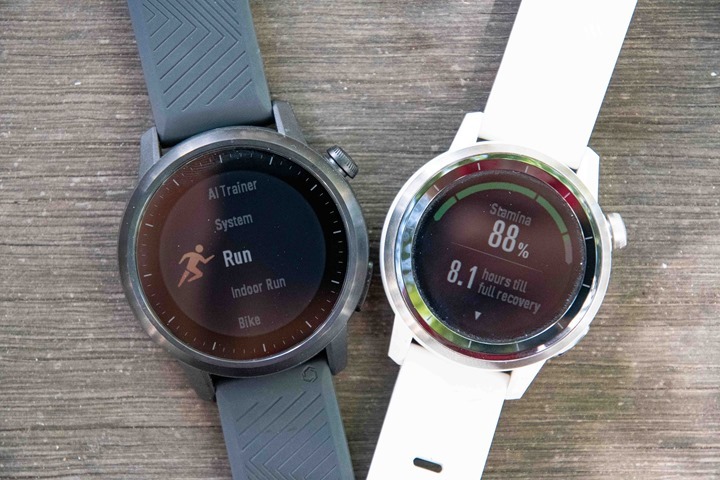
It'due south likely the reason yous bought the COROS APEX is for sport usage. And so let's become kicking into a sport fashion. Simply tap the digital crown and and so you're presented with a list of sports to select. At present they are:
– Run
– Indoor Run
– Bike
– Indoor Bike
– Pool Swim
– Open up Water
– Triathlon
There'south likewise a 'System' option and an 'AI Trainer' pick, simply more than on those afterward.

Once you've selected a sport mode it'll beginning acquiring your eye rate, besides as GPS signal (if an outdoors activity). You lot've also got the choice of either starting an open-ended activity, or doing Interval/Aerobic/Anaerobic Training.
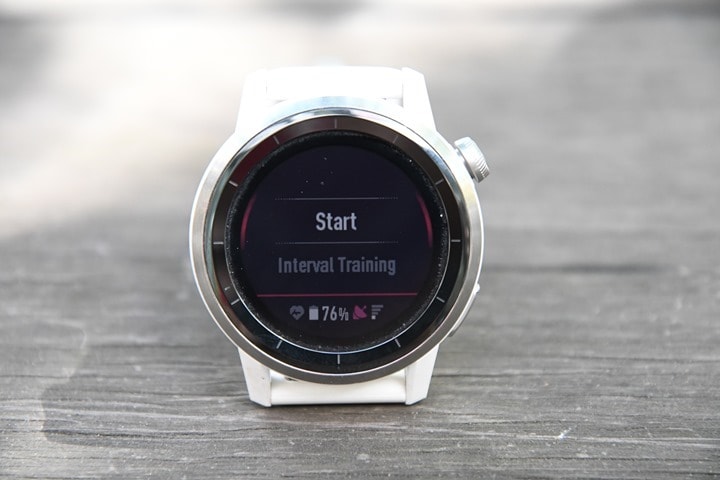
The training modes are actually pretty interesting. It's basically filling buckets inside sure HR times, to reach the desired impact. It'due south frankly a rather logical mode of doing it.
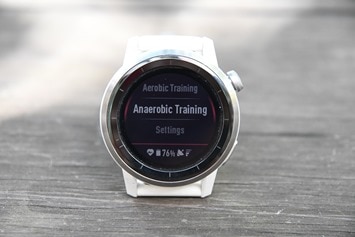
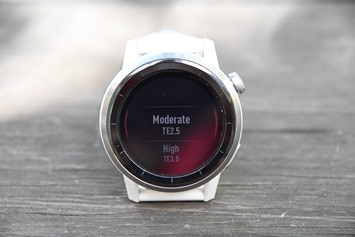
You can as well shortcut into settings, and enable Automobile-Pause, too as distance, pace, cadence, and Hour alerts. Distance alerts are based on preset distances, whereas the others are based on ranges (similar 140bpm to 150bpm).

You lot can also configure basic intervals, using either time or distance for the work/balance portions, plus a separate warm-up and absurd-down. You lot can't download structured workouts to it, but as a basic interval mode it's pretty handy.
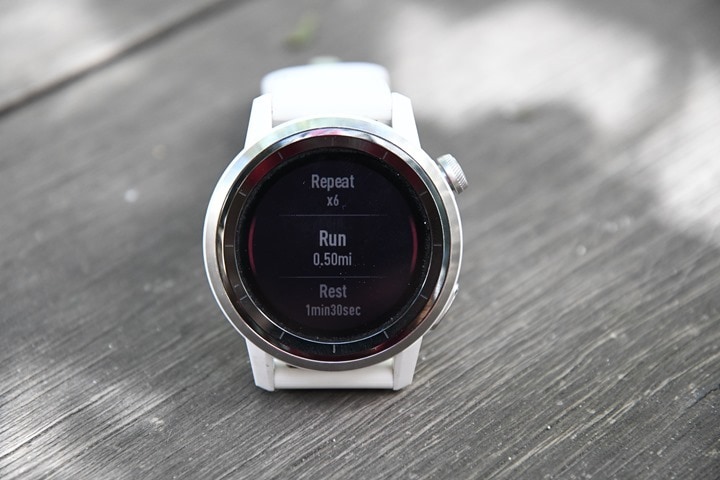
We'll go ahead and keep things unproblematic for now and simply practise a regular run, sans-alerts. Once yous've got GPS and Hour lock, the icons will stay solidly lit, and you're ready to roll. Printing the digital crown once more and off yous go. I exercise similar that if it doesn't have lock yet on those, it'll warn you that things won't be good. A nice touch on that other companies omit.
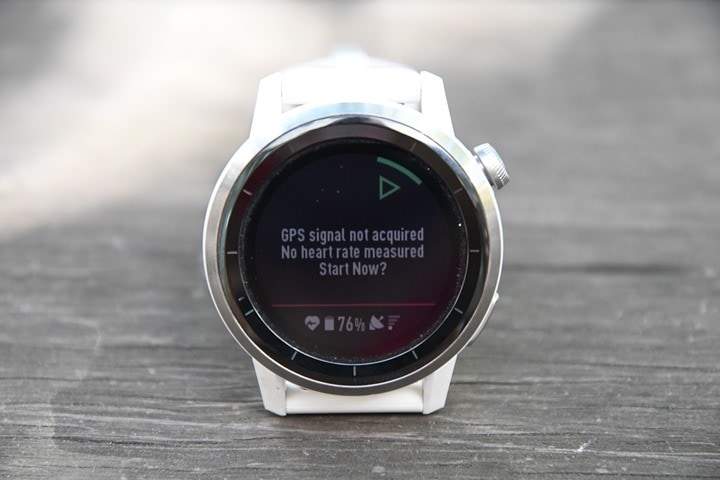
Once started you lot'll encounter your information on your default data pages:
You can scroll through the data pages using the digital crown, which is virtually the most impossible matter ever when doing intervals. Information technology'south just not good. While Apple tree uses a digital crown on their Apple Watch, you typically alter information pages by just swiping the screen. Just the COOS APEX isn't a touch-screen, so no swiping here. I go that when sitting in a conference room the digital crown might exist fine, I notice it but annoying when running difficult – or cycling.
You can press the lower correct button to trigger a lap at any fourth dimension:
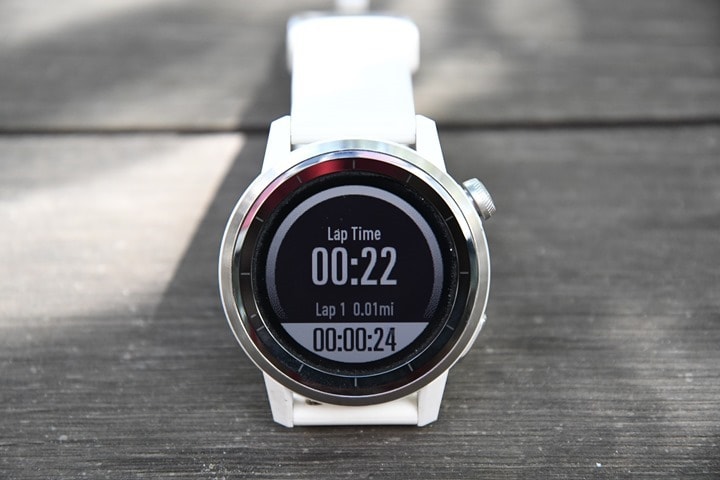
Information technology'll show you the electric current lap time and lap altitude. At this point that'due south non customizable.
Notwithstanding, what is customizable is the data pages. To alter these y'all'll select the 'Custom Interfaces' option within the phone app, and then choose the sport you lot want to tweak:
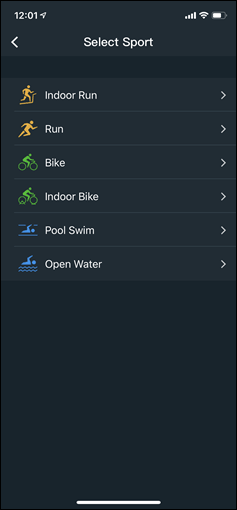
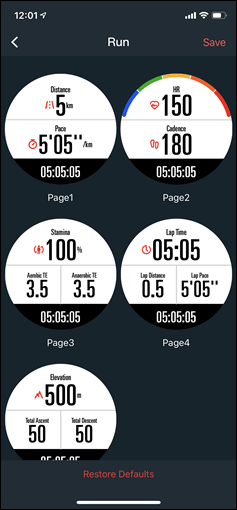

Y'all get 5 data pages yous can customize, with between 2 and 6 pieces of info – more than whatsoever Garmin GPS running picket (on a per page basis, Garmin allows more than pages):
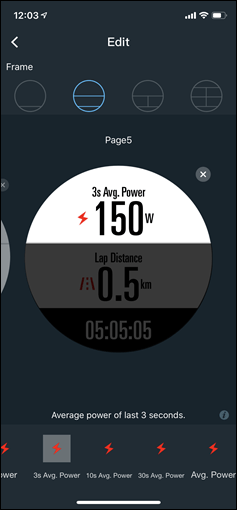
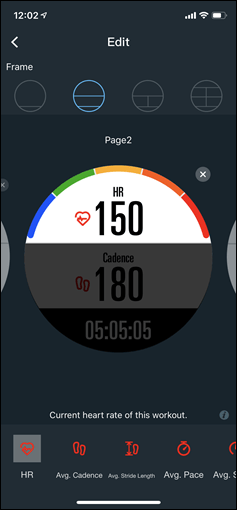
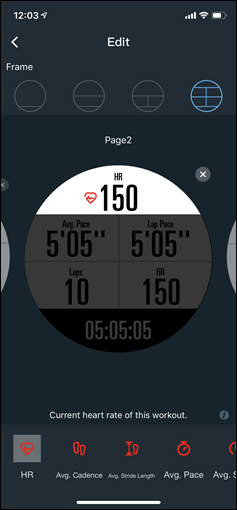
For those cyclists in the room, you lot can display power also, including normalized power (NP). It'southward not clear if they've licensed this from TrainingPeaks like others, or just are using it. Either fashion, information technology's at that place for at present.
Speaking of sensors, y'all can currently pair Emmet+ sensors. Information technology does non support Bluetooth Smart sensors. At present it supports Emmet+ power meters, Emmet+ heart charge per unit straps, Pismire+ cadence sensors, and ANT+ speed sensors. No footpods yet. I used information technology with both a power meter and on a few activities also a heart charge per unit strap:
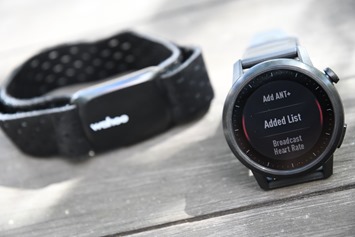
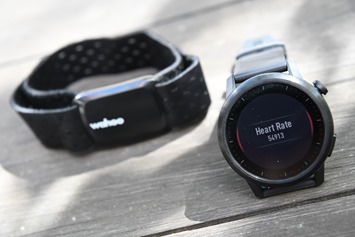
Looking at cases where I recorded a ability meter to the COROS APEX and besides to a secondary Garmin device – the ii plots of power meter data matched perfectly. So at to the lowest degree for that item unit (Stages LR), it worked just fine. However, be warned that the COROS APEX cannot calibrate (nil offset) your ability meter. So be sure you've got some other app to practise that.
COROS also added re-broadcasting of heart rate over Pismire+, matching Garmin and skipping ahead of both Suunto and Polar which lack doing and so over Bluetooth Smart. I didn't utilize this feature because the mode its implemented requires being in the circulate-only widget mode, versus assuasive me to enable it within a specific sport fashion and still track on my spotter.
Later yous've completed a conditioning you'll be able to review the stats from the workout on the lookout:
These are then synced to your phone once you lot've opened the COROS app and it's brought to the forefront (information technology doesn't seem to sync in the background for me). It's an easy to read and clean bones layout of stats:
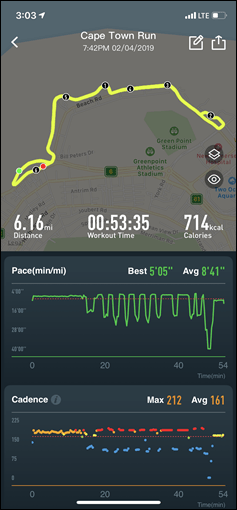
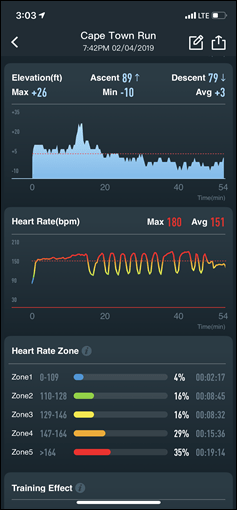
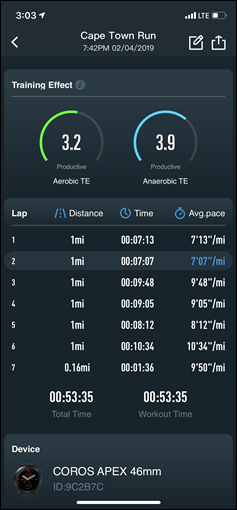
If y'all've configured sharing of the information, it'll go to Health Kit, Strava, TrainingPeaks, and WeRun:
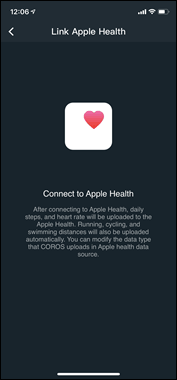

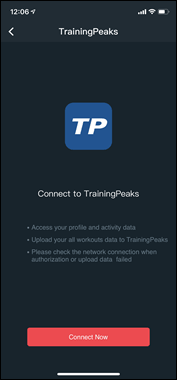
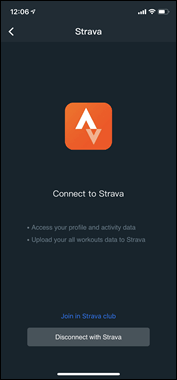
Alternatively, you can share a workout directly from the app via .FIT/.TCX/.GPX/.KML/.CSV – which is great, and and so to various apps.
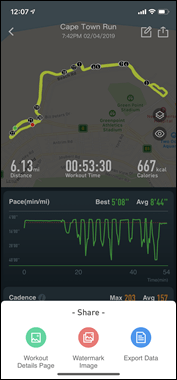
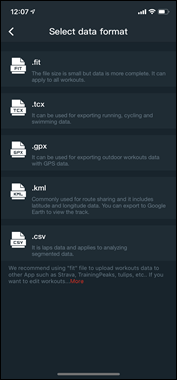
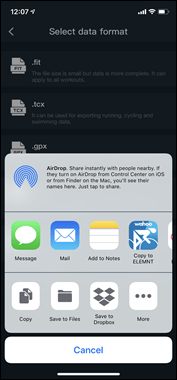
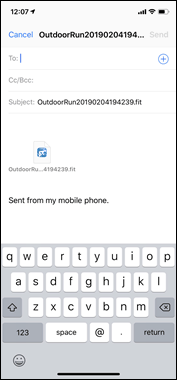
I'd love to come across the company add direct Dropbox support. I call up that'd be a striking with some of the geeks in the house, myself included.
Finally, let's talk almost the grooming load related stats.
When I first talked about the Apex months ago, I expressed skepticism that the visitor had washed much due diligence on this front end, compared to incumbents like FirstBeat and Polar (and many others). This skepticism was based on conversations where the company said they had done all the development work in-house, a bit of a crimson flag for a company that didn't announced to have sport scientists or similar on staff.
Don't get me incorrect – there's enough of times I disagree with the assessment that either FirstBeat (who Garmin/Suunto/others use) or Polar gives me in terms of my workout load. And I besides get that for some people, the assessments may not reflect reality (for me they tend to be very shut). Withal, this really isn't about that. It's about the fundamentals of their training load platform not adding upward.
Withal, let's ramp into this one pace at a time, in the same lodge equally the app would show information technology. The first field you have is the one labeled 'Training Load'. The nautical chart attempts to plot the rise and autumn of training load based on individual workouts. Except, there's no logic to it. On days I throw downward difficult workouts, a few hours later it shows my preparation load at under half that. And then when I go out the next day and apply some other difficult workout, it doesn't ascent. Here's ii screenshots (one I took ii days prior, one I took today at correct).
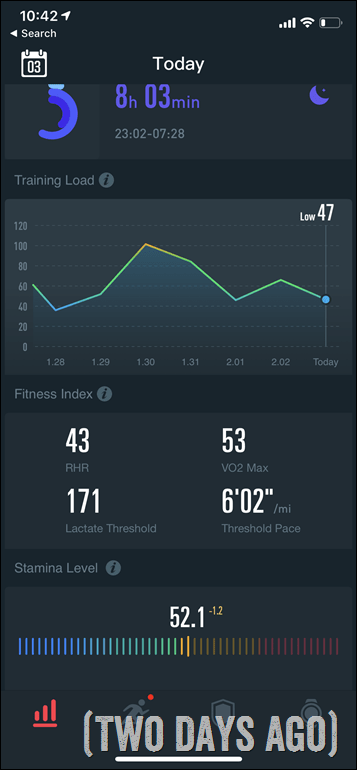

Now in the i to the correct with that orangish summit, that day is a flake skewed (higher) because I was wearing two COROS watches for an interval workout. Only that proves my betoken even more: It's got double the accumulated load of a reasonably stiff interval conditioning, yet the next day it unexplainably drops by more than than half to 50 (and I oasis't washed annihilation withal – it shouldn't plot anything yet unless information technology's doing time-based depreciations like EPOC, which it isn't, since it doesn't depreciate throughout the twenty-four hours).
Even more – wait closely at the numbers to a higher place on Jan 31st, it really changes the values down the road. Two days ago my preparation load value for January 31st was ~85, but then today it's now showing at ~forty. Huh?
To demonstrate how piddling seems to exist understood about this – consider the duration they prove the preparation graph at: Just ane week. It's unchangeable.
The entire point of tracking training load is over many weeks, months of data. Y'all tin't see anything in a calendar week. Garmin, for example, has iii settings (seen higher up) – 4 weeks, 12 weeks, and half dozen months. Polar shows a one-week view but when you click on the chart it expands out to three months past default. Suunto allows you to change the fourth dimension calibration every bit well. Everyone does – that'southward the *singular point* of preparation load.
Next, let's look at the 'Fitness index' section:

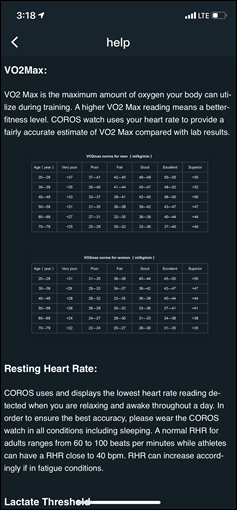
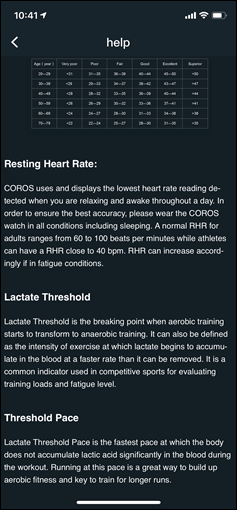
Here, they got RHR (Resting Heart Rate) right, and so that's good. Because even some of the biggies screw this up. Though, some of the big companies also at present divide out RHR while comatose versus awake. Then it shows my VO2Max as 53. That's depression. I'chiliad tested at 61 (albeit a few years ago, but that wouldn't shift), merely 53 is far too low.
Inversely though information technology randomly lists my *threshold footstep* at half-dozen'02"/mile (iii:45KM). To begin: No. Merely no. Every bit much I'd love for that to be the example, it's simply not. Threshold pace is roughly considered 15-20 secs/mile slower than 10KM footstep. For the moment, let's just presume my 10KM race pace is a simple 4:00/km (6:23/mile, and then a 40min 10KM). It might exist faster, or a fleck slower, merely that'southward a rubber number for me. That would put my threshold pace at 6:twoscore/mile, not half-dozen:02/mile.
Simply here's the thing – I'm not even upset about it being off past 40-seconds/mile. I'yard bellyaching they don't double-check their ain numbers. For my historic period/gender (36yo male), it'd be nigh impossible with a 53 VO2Max to have a threshold pace of 6:02/mile. That would imply a five:45/mile 10KM pace, or a 35-minute 10KM road race time. All inquiry out in that location indicates that would crave a VO2Max of 60 (not 53 as indicated past the app).
What'southward funny in that location though is that the app itself actually pulls the Cooper Institute tables (which is widely used by many organizations to yardstick performance), only they don't seem to heed any of the underlying metrics from that system. I don't know where the lactate threshold value is coming from in the COROS app. Though, information technology does manage to match my Garmin value at 171bpm. So I'll requite them that.
Adjacent, below that is Stamina:
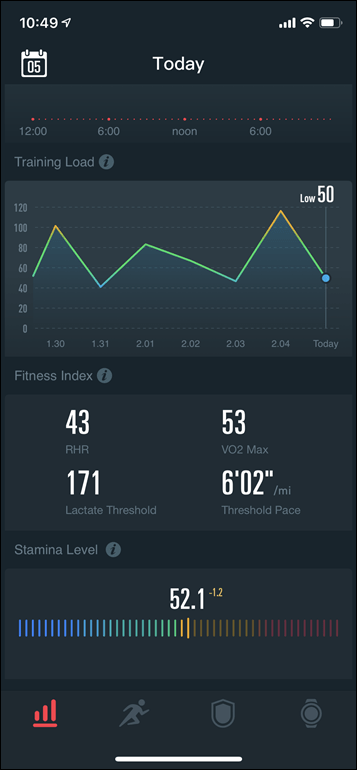
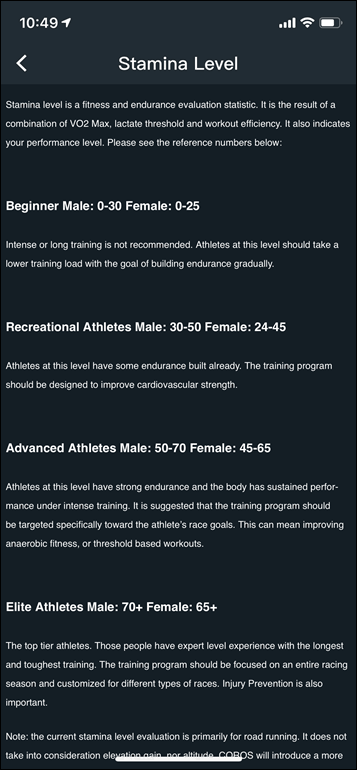
It claims to exist a combination of VO2Max, lactate threshold, and workout efficiency. In general, I'm really non opposed to such a number, just since this is based on the metrics higher up that are skewed already, the foundation right now hither is shaky. Since my VO2Max is clearly off, and so this number will be off.
With that, there's something called 'AI Trainer', that's attainable in the sport bill of fare. This appears to exist taking recovery into business relationship, and shows how many hours are left for full recovery:
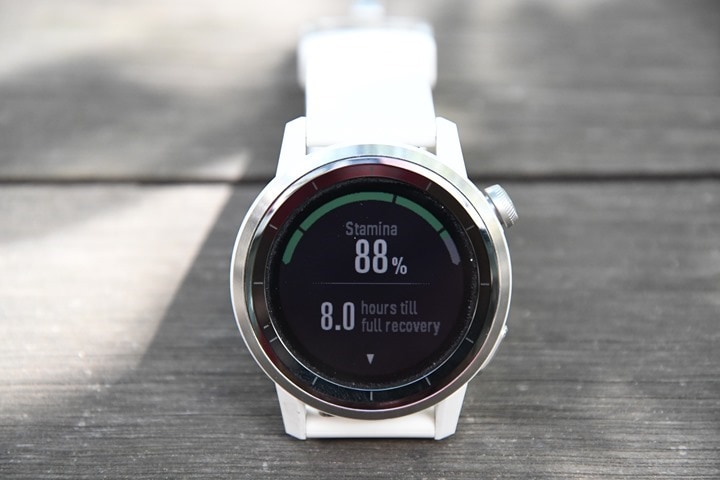
Ignoring the fact that the algorithm recovers far too fast (like 2x besides fast), the usage of the term 'Stamina' hither is indistinguishable of the term in the previous screenshot, and they don't match in terms of actual data or purpose. This one here shows 88% (decreasing from 100% during a workout and rising once again afterwards), while the other 1 shows 52.one (non percent). 1 shouldn't take two totally dissimilar metrics named the name thing. In talking with COROS, they hold and are looking to change the app-driven one to something else. This particular Stamina concept I do similar – since it reminds me a little chip of what Xert is doing with some of their metrics.
Finally, notation that yous can configure heart rate zones within the app's settings. Tap the picture of yourself, and then you can change them to evidence zones in 'Lactate Threshold Zone', 'Max Eye Rate Zone', or 'Heart Rate Reserve zone':
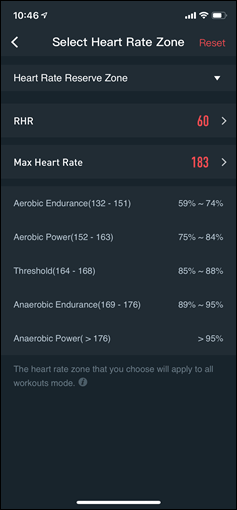
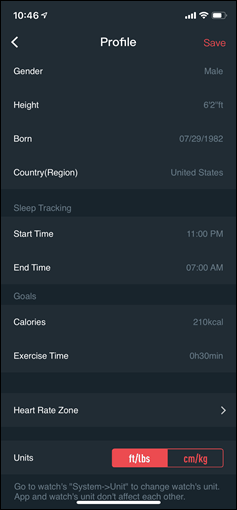
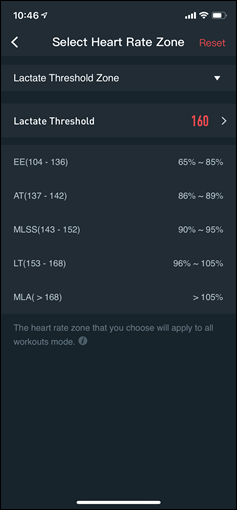
This is also where yous ready RHR, because while COROS volition measure RHR, it doesn't utilize the measured number for any recovery calculations. Confusingly it uses this statically gear up number deep in the menus. While that might have impacted some recovery metrics, it wouldn't have impacted my specific concerns on training load – since my concerns were focused on how things are displayed more than the actual number itself. Finally, note that at this bespeak these zones are not bachelor beyond middle rate to areas such as cycling/running power.
GPS Accuracy:
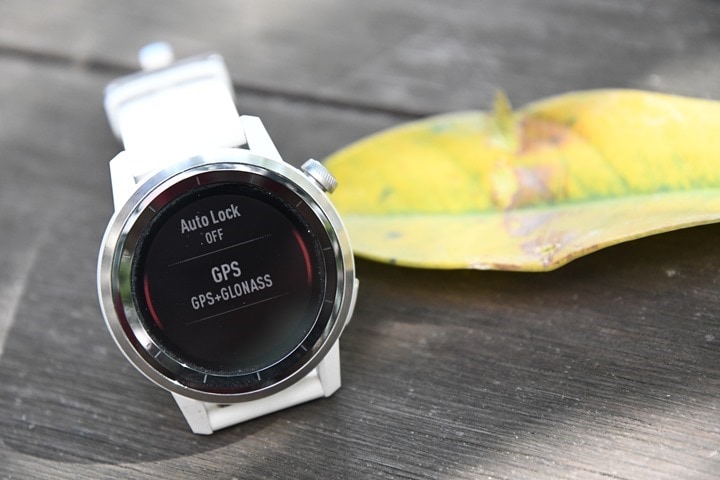
In that location'due south probable no topic that stirs every bit much word and passion as GPS accurateness. A watch could autumn apart and give you dire electric shocks while doing so, but if it shows yous on the incorrect side of the road? Oh hell no, bring on the fury of the internet!
GPS accurateness tin be looked at in a number of unlike means, but I prefer to wait at it using a number of devices in existent-world scenarios across a vast number of activities. I use 2-half dozen other devices at once, trying to go a clear flick of how a given set of devices handles conditions on a certain twenty-four hour period. Conditions include everything from tree/edifice cover to weather.
Over the years I've continued to tweak my GPS testing methodology. For example, I effort to not identify 2 units side by side to each other on my wrists, as that tin impact signal. If I do and then, I'll put a sparse fabric spacer of about one"/3cm between them (I didn't do that on any of my COROS APEX workouts). Simply often I'll only carry other units by the straps, or adhere them to the shoulder straps of my hydration haversack. Plus, wearing multiple watches on the aforementioned wrist is well known to affect optical 60 minutes accuracy.
Side by side, equally noted, I employ only my daily preparation routes. Using a single route over and over again isn't really indicative of existent-world conditions, it'south just indicative of one trail. The workouts yous see here are just my normal daily workouts.
I've had quite a bit of variety of terrain within the fourth dimension period of COROS Apex testing. This has included runs in: Amsterdam, Nevada: Las Vegas + Nearby Mountains, and Cape Town, South Africa. Cities and countryside, mountains, copse, desert, oceans, and open-air. Information technology'due south been everywhere!
Let's go correct into it with a relatively easy run alongside the waterfront final night. This was an intervals conditioning, but it was more often than not on the promenade and/or sidewalks, making it actually actually easy to spot when the GPS rails goes amiss. At that place were a few points where I was near some buildings, simply those were somewhat rare. Here's the data set from that:
This is a unique set up in that I've actually got not one, but two COROS APEX units on this run. On my left wrist I take the COROS Apex 42mm, whereas on my correct wrist I've got a COROS Noon 46mm. I've as well got a Garmin FR935 and Suunto Trainer Wrist Hr along for the ride as well, mostly collecting HR data from other straps.

At a high level, things look pretty strong. No obvious issues. Let's zoom in a flake though, here'due south the kickoff looped expanse:

With the exception of the part near the sandy beach, the COROS Noon units are spot on. However, near the embankment the 42mm does become off and play in traffic – something generally frowned upon hither. The Spartan though does briefly do the aforementioned as I'm finishing my cool-down though.
Along the waterfront edge the 42mm seems slightly first from the balance. Not a huge amount, maybe three-v meters. Simply noticeable:

However, in one case I turn the corner a few hundred meters later on it seems to sort itself out, and the main section where I do pregnant back and forths for my intervals is perfectly on-point:

Finally, what's somewhat interesting here is the altitude totals recorded by each unit of measurement. Both the 2 COROS watches were notably below the Garmin and Suunto watches – by almost 200m. I don't really know where they lost:

There's no single moment where information technology lost the distance, but rather, a very slow roll. You can encounter the gap very slowly separating throughout the run.

Side by side, let's caput out for a run through Amsterdam'due south Vondelpark. In this example compared against a Forerunner 935 and Vantage M. Here's that data ready:

Y'all can see right off the bat from the view above that the Vantage M is struggling in certain sections of the (mostly wide open) park. Notice how that blood-red track is off in the buildings/wood on both the northern portion, only also offset on the lower southern portion. However, the COROS Apex matches nearly perfectly the FR935 – and right on track on the northern portion.
But on the southern portion it's slightly beginning from the trails, matching the Vantage Thou a bit.

Towards the eastern edge of the park you see the Vantage Grand continue to struggle, only actually and so does very briefly the COROS Noon. You see it dip through ane department of pond there. Had it been summer people would accept been sunbathing there likewise and trampling over them, merely this time of year you'd just have been cold and wet with the ducks.

Notwithstanding, on the whole it'southward pretty close. Not as skillful equally the FR935 in this example, but meliorate than the Vantage M.
Now, let's transition to some road riding. First back to the deserts almost 45 minutes exterior of Vegas. This is interesting because while this entire ride was on asphalt, some sections were on tight and winding wheel paths – a cracking test of GPS:

At a high level it looks fine, and indeed, on the roads it was. Only it's those smaller wheel paths that things sometimes go off the rails…err…road. For example, you can see this turn here where the Vantage 1000 just cut straight across. Note, this was a low-speed turn (going uphill). The COROS APEX nails these backs and forthsb without whatsoever result at all.

Same here where the rail is spot-on and only the Vantage M struggled.

Since this ride had some dainty elevation changes in it, let'due south take a quick diversion over to acme related stats. Subsequently all, that'due south a primal selling signal of this unit over well-nigh other sub-$300 multisport devices that lack a barometric altimeter:

Y'all tin can encounter that it and the Stages M50 while offset, exercise mirror each other. I don't know which 1 had the correct starting height, but I like that they maintain their starting time throughout. The COROS Apex does allow you to ready the elevation manually if you desire, or you lot can utilize GPS to obtain the initial lock. The Polar Vantage Thou lacks a barometric altimeter, but actually didn't do too bad here at all. A bit smoothed as is frequently the case, but nice.
And then we've got one last ride – this time a ride here in Greatcoat Town along the coast on a relatively wide route, but up against some cliffs in some sections:

Every bit I departed the city areas, things were pretty solid from all units, including the COROS Apex. No issues with buildings:

All the same, every bit I started to head out of town, there were definitely a few spots were the Vantage Thou sliced the corners a bit (in orange on these charts). The COROS APEX didn't exhibit that consequence.

Same goes for other areas of the road – it nails them all perfectly.

Lastly, permit's look at an openwater swim or 2. Hither's 1 from a few days ago upwardly at a reservoir outside of Greatcoat Town. From a topography standpoint information technology basically sits atop a mount, and has broad open up lines of sight – so zero GPS disrupters here! On one wrist I had the COROS Apex, while the other wrist had the Polar Vantage M (both in swim mode). And then, for track reference I had a swim buoy with both a Garmin FR935 and Suunto Trainer Wrist HR in only regular running style (so they properly track every second, whereas openwater mode would effort and apply fancy algorithms to them):
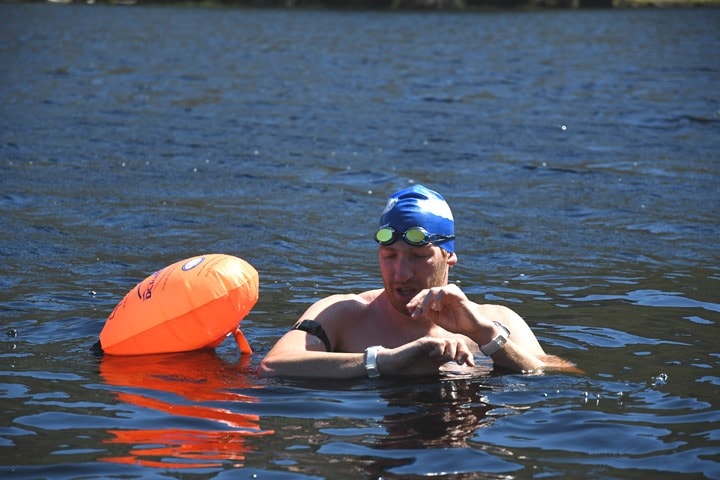
Ultimately, here's what that data ready looked like:

In retrospect I should take but done one loop, because it makes it harder to come across. On my 2d loop I realized this and decided to split the lake downward the middle. And so let's remove everything except a unmarried reference track and the COROS APEX:

You tin can see that information technology's all over the place here, like the Polar Vantage M rail compared to the reference is beneath. Notwithstanding, the APEX is worse because it wiggles effectually even more (thus falsely calculation distance), plus, it draws a shark fin in the upper corner.
Below is the reference track compared to the Vantage M:

Note that the best openwater GPS tracks I've seen to date take actually come from Apple. Here'southward a video I did back in October – including the COROS Footstep series as well on openwater swim GPS testing:
Oh, as for the other recent swim, information technology was a few days ago besides. This is an *incredibly tough* swim for GPS units to runway, due to ane swimming in a culvert (maybe 2ish lanes wide) with 4-eight story buildings on either side of information technology. Even the reference GPS track struggled. While the other wrist-based unit on this swim was the Polar Vantage M (and the track was really bad), it wasn't nearly as useless as the COROS Noon.
The APEX recorded in the (very crude) ballpark of the right distance, but the actual GPS track only managed to connect my starting time and terminate points – a mere 50m away from each other (I've highlighted it in yellow – that tiny picayune line):

Look, on this particular swim route (the most challenging GPS-wise I've ever swam), I'one thousand not expecting miracles. But, I'm also expecting information technology to at least plot more than the start and finish points. Polar gets some points for managing to very vaguely plot the return trip (albeit missing the front one-half).
Now, openwater swims aside, GPS accuracy for me has been very close. Not the all-time I've e'er seen, but notwithstanding more than practiced enough for nearly people. Notation that at this bespeak it's simply GPS+GLONASS, though, I haven't seen significant gains nonetheless from Galileo in most of the watches I've tested. Of course, the full satellite constellation is only just coming online, so things should become better there soon.
Ultimately though, I don't have any major country focused complaints on the COROS Noon when information technology comes to GPS accurateness.
(Note: All of the charts in these accuracy portions were created using the DCR Analyzer tool. It allows yous to compare ability meters/trainers, center rate, cadence, speed/pace, GPS tracks and plenty more. You can use it as well for your own gadget comparisons, more details here.)
Heart Charge per unit Accuracy:
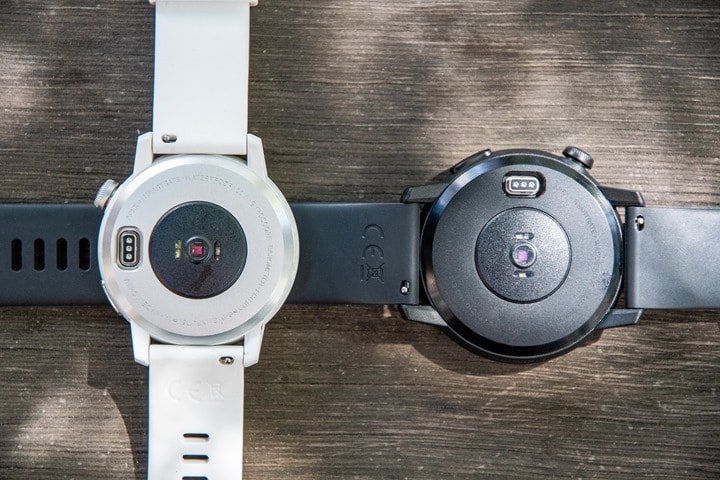
Earlier we movement on to the test results, note that optical Hour sensor accurateness is rather varied from individual to individual. Aspects such as skin color, hair density, and position can impact accuracy. Position, and how the band is worn, are *the most important* pieces. A unit of measurement with an optical Hour sensor should be snug. It doesn't need to leave marks, but y'all shouldn't exist able to slide a finger under the ring (at least during workouts). Yous can clothing it a tiny bit looser the remainder of the mean solar day.
Ok, so in my testing, I simply employ the picket throughout my normal workouts. Those workouts include a broad variety of intensities and conditions, making them neat for accuracy testing. I've got steady runs, interval workouts on both bike and running, pond, also as tempo runs and rides. Basically, most everything a typical triathlete would do.
For each examination, I'thousand wearing additional devices, ordinarily 3-4 in total, which capture data from other sensors. Typically I'd article of clothing a chest strap (usually the Garmin HRM-DUAL, Polar H10, or Wahoo TICKR), likewise as some other optical HR sensor watch on the other wrist (and sometimes also either the Scosche Rhythm 24, and Polar OH-1). Notation that the numbers you run into in the upper correct corner are *not* the averages, but rather just the exact point my mouse is sitting over. Note all this data is analyzed using the DCR Analyzer, details here.
Let's dive right into things, get-go up with a run from two weeks agone. More or less a straightforward run with a bit of intensity shift in the middle as I climbed upwards a tiny chip, but otherwise pretty vanilla. Just we desire to kickoff easy and then crank the screws with each successive set. Here'due south the DCR Analyzer set if you want to dig in deeper yourself:

We see the overnice and proper gradual increase in intensity from the HRM-DUAL whereas the Vantage M and COROS APEX don't quite get it right. The COROS does some weird bobble, and the Polar follows lonely slightly under every bit well. Virtually 3 minutes into my run I'thousand nevertheless at 110bpm according to it.
Across that point though, the three sorta agreed – the Noon is generally in agreement with the HRM-DUAL, though the Vantage M has these weird bobbles.

I'd bespeak out this petty bump here:

This piffling spike in HR (only up to 164bpm) is spot-on right past the HRM-DUAL. It's when I went a scrap harder up a short/steep hill. Not all out, merely plenty that you notice it. Whereas the COROS Apex and Vantage K missed the gunkhole.
And…time for another run. This one dorsum in Vegas and by and large steady-country on/off road. Same coiffure – Polar Vantage M (in dark-brown), COROS APEX, and HRM-DUAL. Here's the data:

You see a nice clean build by most of them, just slightly nicer from the HRM-DUAL. Shortly after that the Polar Vantage Chiliad completely loses the plot for about 4-6 minutes for some unknown reason, but the COROS APEX holds on pretty well. After that moment the dip for all of them is me taking a picture at the 'Leaving Las Vegas' sign (so the dip is correct). From there, the residue of the run is pretty much the same for all of them, save a few brief bobbles from the Polar Vantage M.
Next, we've got an interval run from a calendar week ago. This had a ton of 60 minutes data to expect at.

On my left wrist is the Polar Vantage G (xanthous), whereas my right wrist has the COROS Apex 42mm. Meanwhile, I'one thousand wearing the Garmin HRM-DUAL on my chest, while my upper left arm has the Polar OH-1 optical sensor, and the upper correct arm the Scosche Rhythm 24 optical sensor. All these are therefore properly separated. In that location's no more cute HR testing setup I can call back of than this.
The conditioning was an interval conditioning: ten-minute warm-upwardly, then 6x400m, then 2x800m, and and so 2x30s sprints, all with 90s recovery between each set. Oh, and a brief absurd-down. Allow's look at the warm-up:

Y'all tin see the HRM-DUAL chest strap struggled to take hold of onto my middle rate (in bluish). Why? Well, that was technically my mistake. I had wet the strap prior to departing the house, but by the fourth dimension I walked downward to the waterfront it had dried in the cooler morning time air. A key effect with chest straps that has been around for decades. In one case I looked down a few minutes into the run and realized this, I applied some spit to the strap and it immediately rectified itself. As for the Polar Vantage M optical HR sensor (yellow/orange)? Information technology's completely and totally lost during this until the decision of the warm-up when I start walking.
Allow'south look at the vi 400m sets:

Here's my quick analysis of all six sets:
#1: All skilful except Polar Vantage 1000 losing the plot briefly
#2: Polar Vantage-M missed the recovery by 20bpm, Garmin HRM-DUAL struggled to find lock, COROS Noon also struggled to detect lock, Polar OH-i blip
#3: Polar Vantage-Grand good, Garmin HRM-DUAL struggled to find lock, COROS APEX a wee flake delayed, cursory Polar OH-i bleep
#4: Polar Vantage-M lost the plot, Garmin HRM-DUAL struggled to find lock, COROS APEX a scrap delayed
#5: Polar Vantage-M good, Garmin HRM-DUAL failed entirely
#6: All more often than not good hither, though, a flake of a delay on HRM-DUAL into the recovery.
Hmm. I remember moving the strap slightly on my chest at some indicate towards the 5th or then interval, and that seems to help the Garmin HRM-DUAL strap from at that place on out. Check out the remaining 2x800m and 2×30-second sprints:

You can meet here the HRM-DUAL was perfectly fine (forth with the COROS Noon), whereas the Vantage-M totally missed both by a wide clamper (specially notable since these were twice as long, so information technology had twice as long to effigy it out). The pace for the 800m was a half-dozen:23/mile (4:00/KM), and the footstep for the sprints was effectually 5:00-v:30/mile (iii:00-iii:30/KM). So plenty of variety from a cadency standpoint.
I accept zero idea why the HRM-DUAL failed here and then badly on the first 6 sets. I haven't seen that elsewhere. And typically when we see failures in intervals, information technology's exceedingly rare to see them for chest straps. It'southward almost e'er optical, not breast straps. Maybe it was something ecology, or perhaps my shirt or something weird (though, it'south the same shirt I've run in quite a bit lately). Inversely, I don't know why the Vantage One thousand failed on the 800's. Sigh.
The COROS Noon wasn't the worst of the bunch, but it definitely wasn't the best either.
All the same, I'd seen enough weird quirks that I wondered if there were differences betwixt the 42mm and the 46mm. For example – what if I put one on each wrist and did the interval workout once again? Enquire and you shall receive – here'due south last night'southward workout:

I've likewise got Wahoo TICKR-FIT information alongside HRM-DUAL data in in that location as well. But I was really bummed, considering both the Scosche Rhythm 24 and Polar OH-i failed to assemble the data in the offline modes. I'm sure it's probably user error, but information technology's still frustrating even so.
You can see though that the 42mm struggles right out of the gate, and then again through 3 of the 6 intervals (the 400m ones). For the 2x800m intervals, it nails those perfectly. And for the two xxx-second sprints, it completely misses the boat. Oddly though, the 46mm only messed upwardly once: The final walking cool-downwardly (somehow).
I'yard not sure what to make of this, but information technology's interesting even so.
Next, let's head out cycling– this fourth dimension out to the desert for a couple hour wander past wheel. This ane was interesting because the efforts varied quite a chip. It's compared against the Garmin HRM-DUAL strap and Polar Vantage M watch (optical), and it allows you to run into how well things work in very absurd/dry out environments (it wasn't hot), also as with a bit of current of air. The HRM-DUAL was recorded to the Stages M50 unit. Here's the data files.

At offset you might fifty-fifty think the Polar Vantage Grand was paired to the HRM-DUAL, but when you look more closely you can see the nuanced differences. The Vantage M optical sensor lags a little bit, and in some parts of the ride differs considerably – especially for short burst efforts. All tell-tale signs of an optical HR sensor that'southward struggling slightly. Still, on the whole, this is actually one of the best performances I've seen from the Polar Vantage M in harder conditions. The COROS Noon meanwhile, is mostly lost the vast majority of the time.
Meanwhile, on the fashion back you can run into areas in yellow where the Vantage Thousand was significantly behind the chest strap (I've highlighted the chest strap beneath, just you tin can encounter the red Polar line offset from each of these). Once more, semi-common optical 60 minutes lag. Whereas the COROS APEX in blue (42mm) was pretty much perpetually wrong by huge amounts.

I don't generally like to await at averages across a ride/run/anything, because a unit tin be totally wrong the entire time and nonetheless get a close boilerplate. Nonetheless, you lot can see the boilerplate center rate between the Stages (which is what the HRM-DUAL was paired under) and the Polar Vantage M, in comparison to how far apart the average is for the COROS Apex.

Terminal but not least nosotros've got an openwater swim. Actually, I tried to practise a few openwater swims and assemble HR data, but Polar'south H10 offline caching thing with the Polar Vanquish app is a hot mess. For my first effort at it, I didn't put it in the correct mode evidently, and thus it didn't cache/download the data right. On my second swim, the information came out completely useless. As if the strap was malfunctioning. Of grade, all of this strap data downloading should absolutely be built into the product like it is for Garmin/Suunto, but it's not.
In any instance, hither'due south a look at some 60 minutes data I captured earlier in the week during a swim. On this swim, I've got the Polar Vantage K on i wrist, the COROS APEX on the other, and so a Scosche Rhythm 24 on i upper arm. I wore the Polar H10, simply again, that data was useless. Hither's the data set:

The yellow/orangish color is the Polar Vantage M. While I'thou non entirely sure who is right, I'1000 going to approximate that the Vantage M is correct for at to the lowest degree the first x minutes or so. Generally since there's little chance my 60 minutes was seventy-80bpm while swimming. Then around the eleven-infinitesimal marker the COROS APEX goes a chip wonky for a few minutes. And past 'a few minutes', I mean the balance of the swim. That's definitely non right.
Withal, the Polar Vantage M and Scosche are pretty similar. Certainly not as close as we've seen in runs or rides, but not totally misaligned. There'due south one bespeak where the Vantage spikes and the Scosche doesn't. I'd put this in the category of 'mostly believable', but I just don't know for certain.
Of course, if yous've read my reviews long enough you'd know that for the most role I don't tend to see a ton of value in swimming HR. It doesn't marshal as well to efforts every bit running or cycling does in my experience, and is commonly a bit more cumbersome to view due to having to turn your wrist just correct. And for example, the h2o where this swim was in, was super low-visibility, enough that I could barely make out the numbers on my wrist in front of me.
As for HR accuracy on the whole?
Well, I'll interruption it autonomously past the sports I focused on (again, just talking optical HR accuracy here):
Running: Fine for steady-state running, but a really mixed bag for intervals
Cycling: Only bad. About the worst I've seen.
Swimming: Solidly mixed. Might exist some bright points in there, only it's a lot of non the same too.
Looking at the sensor setup they've got – I'd question the arrangement of the LED'due south. In full general, there are reasons why other companies have done them in the ways they've washed them – and COROS should probably consider that when looking at hereafter optical 60 minutes sensor arrangements. I call up at that place's some more work the company could practise in terms of software algorithms, but I don't think they'll have as much flexibility as someone like Polar would in terms of where we could see things shift from hither.
Planned Updates:

Dorsum in November the company briefed me on upcoming features, alongside a timeline of them. The listing included the following at the time:
November:
– Sleep Tracking [Washed]
– Spanish and German Support [Done]
– UltraMax Mode [Done]
– Enable sentinel HR broadcasting [Done]
December:
– Add navigation tracking [Pending]
– Add more than workout modes [Pending]
– Add more sentry face options [Done]
Of form, at that place's actually a bunch more updates that have been added since and then, which can be seen in the release notes. Most are minor tweaks and non major updates. But, information technology'due south appreciated all the same. As of today, COROS says they're hoping for the navigation modes to release earlier the end of Feb.
Even so, I think COROS has a time to come ahead of it in this infinite, but they need to step back a bit. The mobile app (and to a lesser extent the watch) is riddled with errors. Many of them are language/grammar driven, merely non necessarily simply simple typos. Instead, they are fundamentally confusing terms and ways data is presented (as I talked about in the sports section).
Here's my advice, and information technology'south actually rather simple:
A) Hire a small-scale full-time team of athletic-minded people in an English speaking country that tin both vet the product for errors, but also only as sanity checks on functionality and features. I believe COROS needs 4-vi total-time employees that sympathize the end consumer of these very products, but likewise empathise what these features should be doing from a performance standpoint. Ideally having i of these employees with a sport science background would be incredibly helpful. This could also include user interface experts that would permit the company to shift away from duplicating the user interfaces of Garmin's hardware and Apple tree'south software to accept COROS's own unique wait/feel.
B) Plot out a feature list that isn't duplication, just innovation: I know it'south easier to duplicate hardware and software of their competitors, only people do see through that. Y'all don't want to be known every bit the make that but duplicates everything. While COROS is claiming some industry-leading battery life specs for trail running type scenarios in this form factor, everything else is simply very much copies of other companies' features (down to the font). Yet if the company focuses on features similar their existent-fourth dimension mid-workout stamina characteristic, that could exist really compelling.
C) Focus on accuracy: I'thousand not convinced the optical HR sensor on the Apex was designed well for sports. It seems to be more akin to a 24×7 sensor setup than ane driven to deal with endurance sports and sorting through cadence lock bug. While I had practiced results on the COROS PACE, something changed in APEX, exist it hardware or software (maybe to hit those battery specs).
D) Tedious the roll on products: While information technology's desirable to exercise yearly releases to continue up with competitors, I don't think that's what COROS should do here. I remember they need to really fine-melody what they have from a software standpoint, and add in features at that place instead. Once again, I know more than hardware is always better to sell and get media attention – simply you don't desire attending on things that aren't set.
Once more – I really do remember COROS has a strong potential in this space if they can focus on the higher up. They aren't far abroad. They merely demand to footstep back and take a jiff and clean up what they've built. And then give it their own style.
Product Comparison:
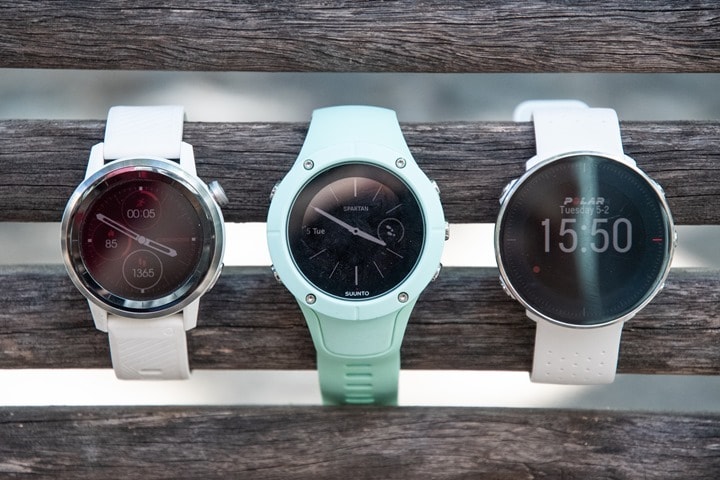
I've added the COROS Apex into the product comparing database, assuasive you to mix and friction match it against other products. Priced at $299, it's theoretically super competitive in the multisport watch scene. Simply the devil is in the details. Then it has many of the big ticket back of the box type features, simply in one case yous scratch the surface it gets a fleck messy. Nuance is a tougher nut to item in comparative charts in some cases.
In any example, for the purpose of this chart I've compared it confronting the Polar Vantage M, Suunto Spartan Trainer Wrist HR, and Garmin Forerunner 735XT. Note that one can still buy the far more capable FR920XT (normally near $200), though it doesn't share the round-watch confront look. Either way, something to consider. Note you tin make your own comparison tables here.
At a simple glance, none of the others on this list have a barometric altimeter. So that's a key item, as are the bombardment run times. Yet inversely, the COROS is the least total featured when it comes to the backend app/platform.
| Function/Feature | COROS APEX | Garmin Forerunner 735XT | Polar Vantage M | Suunto Spartan Trainer Wrist 60 minutes |
|---|---|---|---|---|
| Copyright DC Rainmaker - Updated November 12th, 2021 @ 6:00 am New Window | ||||
| Cost | $299 (42mm), $349 (46mm) | $349 | $279 | $279 ($329 for metal bezels) |
| Production Proclamation Engagement | November 2018 | May 11th, 2016 | Sept 13th, 2018 | August tenth, 2017 |
| Bodily Availability/Shipping Date | November 2018 | May 11th, 2016 | November 2018 | Baronial 30th, 2017 |
| GPS Recording Functionality | Yeah | Yep | Yes | Yes |
| Data Transfer | Bluetooth Smart (smartphone) | USB/Bluetooth Smart | USB, BLUETOOTH SMART | USB & Bluetooth Smart |
| Waterproofing | 100m | Yes - 50m | Yes - 30m | Aye - l meters |
| Battery Life (GPS) | 25hr (42mm), 35hr (46mm), up to 100hrs UltraMax | 14 hours in GPS-on | Up to 30 hours | Upwards to thirty hours |
| Recording Interval | 1-2d | 1S OR SMART | 1s | Variable |
| Alerts | Sound/Visual/Vibration | Vibrate/Sound/Visual | Vibrate/Visual | Visual/Vibrate |
| Backlight Greatness | Smashing | Practiced | Cracking | Cracking |
| Ability to download custom apps to unit/device | No | Yes | No | No |
| Acts as daily activity monitor (steps, etc...) | Aye | Yep | Aye | Yeah |
| Music | COROS Apex | Garmin Forerunner 735XT | Polar Vantage Chiliad | Suunto Spartan Trainer Wrist HR |
| Can control phone music | No | Yes | No | No |
| Has music storage and playback | No | No | No | No |
| Streaming Services | Due north/A | No | ||
| Payments | COROS APEX | Garmin Forerunner 735XT | Polar Vantage M | Suunto Spartan Trainer Wrist HR |
| Contactless-NFC Payments | No | No | ||
| Connectivity | COROS Noon | Garmin Precursor 735XT | Polar Vantage M | Suunto Spartan Trainer Wrist Hr |
| Bluetooth Smart to Phone Uploading | Yes | Yep | Yeah | Yes |
| Phone Notifications to unit (i.e. texts/calls/etc...) | Yes | Aye | Feb 2019 | Yep |
| Live Tracking (streaming location to website) | No | Yes | No | No |
| Group tracking | No | No | No | |
| Emergency/SOS Message Notification (from watch to contacts) | No | No | No | No |
| Built-in cellular scrap (no phone required) | No | No | No | No |
| Cycling | COROS Noon | Garmin Forerunner 735XT | Polar Vantage 1000 | Suunto Spartan Trainer Wrist HR |
| Designed for cycling | Yes | Yes | Yes | Yes |
| Power Meter Capable | Yes | Yes | Yep | Yes |
| Ability Meter Configuration/Calibration Options | No | YEs | Yes | Aye |
| Power Meter TSS/NP/IF | NP only | Aye | No | No |
| Speed/Cadence Sensor Capable | Yes | Yes | Yep | Yes |
| Strava segments live on device | No | Yes | Future Update (Appointment TBD) | No |
| Crash detection | No | No | No | No |
| Running | COROS APEX | Garmin Forerunner 735XT | Polar Vantage M | Suunto Spartan Trainer Wrist HR |
| Designed for running | Yep | Aye | Yes | Yes |
| Footpod Capable (For treadmills) | No | Yes | Yep | Yep |
| Running Dynamics (vertical oscillation, basis contact time, etc...) | Yep | Yep | No | No |
| Running Ability | Yes | Yes with tertiary party devices (not built-in like Vantage V) | ||
| VO2Max Interpretation | Yes | Yes | Yeah | Yeah |
| Race Predictor | No | YEs | No | No |
| Recovery Advisor | Yep | Yes | No | Yes |
| Run/Walk Mode | No | Yep | No | No |
| Track Recognition Style | Yeah | |||
| Swimming | COROS APEX | Garmin Forerunner 735XT | Polar Vantage Thousand | Suunto Spartan Trainer Wrist HR |
| Designed for pond | Yep | Yes | Yep | Yes |
| Openwater swimming mode | Yeah | Yep | Yes | Yeah |
| Lap/Indoor Distance Tracking | Yep | Yes | Yeah | Yep |
| Record 60 minutes underwater | Yeah | WITH HRM-TRI/HRM-SWIM | Aye | Aye |
| Openwater Metrics (Stroke/etc.) | Yeah | Yes | Yes | Yeah |
| Indoor Metrics (Stroke/etc.) | Yep | Yes | Yes | Yeah |
| Indoor Drill Way | Via Drill Log | Yeah | No | No |
| Indoor auto-pause feature | - | No | Yes | No |
| Change pool size | Yes | Yes | Yes | Yeah |
| Indoor Min/Max Puddle Lengths | 15y/m-300y/thousand | 17M/18Y TO 150Y/M | 20M/Y to 250 chiliad/y | 15m/y to one,200m/y |
| Ability to customize data fields | Yes | Yes | Aye | Aye |
| Can change yards to meters | Yep | Yep | Yes | Yes |
| Captures per length data - indoors | YEs | Yes | Yes | |
| Indoor Alerts | Aye | Yep | N/A | No |
| Triathlon | COROS Apex | Garmin Forerunner 735XT | Polar Vantage M | Suunto Spartan Trainer Wrist Hour |
| Designed for triathlon | Aye | Yes | Yes | Yes |
| Multisport way | Yes | Yes | Yes | Yes |
| Workouts | COROS APEX | Garmin Precursor 735XT | Polar Vantage M | Suunto Spartan Trainer Wrist HR |
| Create/Follow custom workouts | Yeah | Yes | Yes | No |
| On-unit interval Feature | Yes | Aye | No | Yep |
| Training Calendar Functionality | Yes | Yes | No | Aye |
| Functions | COROS APEX | Garmin Forerunner 735XT | Polar Vantage M | Suunto Spartan Trainer Wrist 60 minutes |
| Auto Start/Terminate | Aye | Yes | Aye | |
| Virtual Partner Feature | No | Yes | No (just can give out of zone alerts) | No |
| Virtual Racer Feature | No | Yes | No | No |
| Records PR's - Personal Records (unequal than history) | No | Yep | No | No |
| Day to day watch power | Aye | Yep | Yep | Yes |
| Hunting/Line-fishing/Ocean Data | No | No | No | No |
| Tidal Tables (Tide Information) | No | No | No | No |
| Jumpmaster mode (Parachuting) | No | No | No | No |
| Geocaching | No | No | No | No |
| Weather condition Display (live information) | No | Yeah | No | No |
| Navigate | COROS APEX | Garmin Forerunner 735XT | Polar Vantage M | Suunto Spartan Trainer Wrist 60 minutes |
| Follow GPS Runway (Courses/Waypoints) | Yes | Yes | No | Aye |
| Markers/Waypoint Management | Yes | Saved locations simply | No | Yes |
| Routable/Visual Maps (like car GPS) | No | No | No | No |
| Back to start | Yep | Yes | February 2019 | Yes |
| Impromptu Round Trip Route Cosmos | No | No | No | No |
| Download courses/routes from telephone to unit | Yep | Yes | No | Yes |
| Sensors | COROS APEX | Garmin Forerunner 735XT | Polar Vantage M | Suunto Spartan Trainer Wrist 60 minutes |
| Altimeter Type | Barometric | GPS | GPS | GPS |
| Compass Type | Magnetic | GPS | N/A | N/A |
| Optical Heart Rate Sensor internally | Yes | Yep | Aye | Yes |
| SpO2 (aka Pulse Oximetry) | No | No | ||
| ECG Functionality | No | |||
| Heart Charge per unit Strap Compatible | Yes | Yes | Yep | Yes |
| ANT+ Eye Rate Strap Capable | Yes | Yep | No | No |
| Ant+ Speed/Cadency Capable | Yep | Yes | No | No |
| ANT+ Footpod Capable | Yes | Yep | No | No |
| ANT+ Power Meter Capable | Aye | Yes | No | No |
| Emmet+ Weight Scale Capable | No | No | No | No |
| ANT+ Fettle Equipment (Gym) | No | No | No | No |
| Pismire+ Lighting Control | No | Yes | No | No |
| ANT+ Bike Radar Integration | No | Yes | No | No |
| ANT+ Trainer Control (Iron-C) | FTMS (Bluetooth) merely | No | No | No |
| Emmet+ Remote Command | No | No | No | No |
| Pismire+ eBike Compatibility | No | No | No | No |
| Ant+ Muscle Oxygen (i.e. Moxy/BSX) | No | No | No | No |
| Pismire+ Gear Shifting (i.due east. SRAM ETAP) | No | No | No | |
| Shimano Di2 Shifting | No | Yes | No | No |
| Bluetooth Smart HR Strap Capable | Yes | No | Yes | Yes |
| Bluetooth Smart Speed/Cadency Capable | Yeah | NO | Aye | Yep |
| Bluetooth Smart Footpod Capable | Aye | nO | Aye | Yes (+ Stryd Running Ability Meter) |
| Bluetooth Smart Power Meter Capable | nO | nO | Yes | Yes |
| Temp Recording (internal sensor) | Yes | No | Yes | No |
| Temp Recording (external sensor) | No | Yeah | No | No |
| Software | COROS APEX | Garmin Precursor 735XT | Polar Vantage M | Suunto Spartan Trainer Wrist Hr |
| PC Application | No | Garmin Limited | Polar Flowsync - Windows/Mac | PC/Mac |
| Spider web Application | No | Garmin Connect | Polar Flow | Suunto Movescount |
| Phone App | iOS/Android | iOS/Android/Windows Telephone | iOS/Android | iOS/Android |
| Ability to Export Settings | No | No | No | No |
| Purchase | COROS APEX | Garmin Forerunner 735XT | Polar Vantage M | Suunto Spartan Trainer Wrist Hr |
| Amazon | Link | Link | Link | Link |
| Backcountry.com | Link | |||
| REI | Link | Link | Link | |
| Jerk | Link | Link | Link | |
| DCRainmaker | COROS APEX | Garmin Precursor 735XT | Polar Vantage M | Suunto Spartan Trainer Wrist HR |
| Review Link | Link | Link | Link | Link |
Don't forget y'all tin can make your ain comparison tables here in the comparison database.
Summary:
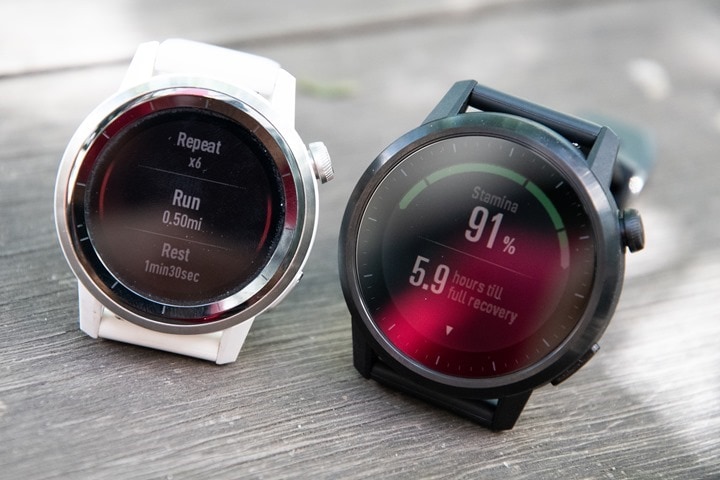
As a brand, COROS is in an interesting spot. It's spending significant capital letter to develop and market watches that appeal heavily to Western audiences, simply its evolution is virtually entirely based in Asia. That'due south not a trouble unto itself, as many great brands accept located significant parts of development and engineering in Asia (non talking manufacturing here, almost anybody does that). The challenge for COROS is that the watch focus seems to be on duplication of competitors, rather than innovation or perfection of the features they do have (such as the training bits).
Even so, there are things I do like. The battery life is amazingly stiff. In fact, I don't even understand how COROS does bombardment life, information technology's and so good. Seriously, I have some other COROS watches that sit quietly for months on a shelf (always showing the watch face) without charging. It's really amazing. Next, the build quality is good. While one can quibble nigh it being a knock-off in the looks department, it does feel good. The materials accept thus far held upward, and it'southward survived numerous brushes confronting difficult sharp physical bits and other prickly surfaces.
And unlike Garmin watches you can actually configure information pages on your phone (though, you tin can't do them on the watch itself). Ultimately that's a bit of a religious battle where some people want to tweak on phone and others on the device itself. Nobody to my knowledge in the spotter space allows both even so. Non to mention I tin put vi data fields on a single folio with COROS, admitting far less fields than Garmin offers.
And of form – the price is compelling, at $299 they've nailed that piece. Unlike the previous plastic COROS Pace which was as well $299, they seemed to take listened here and that's a really strong cost for them, considering the hardware.
Only I just wish the app and software matched the hardware.
I don't experience similar the new training load metrics are actually fully thought out. While one can have a discussion about preferences between Garmin/Suunto's FirstBeat metrics and Polar's performance metrics, you can't really have that level of discussion with the COROS metrics. None of information technology really adds up the mode its currently implemented, and doesn't seem to pass the sniff exam (it's too got virtually no documentation behind it). It'due south frustrating when a watch bills itself every bit a high-end competitor, but falls short in primal aspects of being a high-functioning watch. And I think the app needs some serious work. It just feels one-half-broiled, especially in the language department.
But the fleck of practiced news hither is that I remember the majority of the hardware (bated from the optical 60 minutes sensor) is incredibly capable. I think if COROS takes that step back I discussed earlier, spends the next 6 months on software features and fine tuning only, they could have a actually astonishing and competitive lookout in the APEX for the fall timeframe. And that would exist super compelling.
Establish This Post Useful? Support The Site!
Hopefully you plant this review useful. At the end of the day, I'thousand an athlete just like you lot looking for the most particular possible on a new buy – then my review is written from the standpoint of how I used the device. The reviews generally accept a lot of hours to put together, so it'south a off-white bit of work (and labor of honey). As y'all probably noticed past looking below, I also accept time to answer all the questions posted in the comments – and there's quite a bit of detail in there likewise.
If you're shopping for the COROS APEX or whatsoever other accessory items, please consider using the chapter links below! As an Amazon Acquaintance I earn from qualifying purchases. It doesn't cost you anything actress, but your purchases help back up this website a lot. Even more than, if y'all apply Backcountry.com or Competitive Cyclist with coupon lawmaking DCRAINMAKER, beginning time users save 15% on applicable products!
And finally, here's a handy list of accessories that work well with this unit of measurement (and some that I showed in the review). Given the unit pairs with Ant+ & Bluetooth Smart sensors, y'all tin can use simply virtually anything though.
And of course – you can always sign-up to be a DCR Supporter! That gets yous an ad-gratuitous DCR, admission to the DCR Quarantine Corner video serial packed with behind the scenes tidbits...and information technology also makes you awesome. And existence awesome is what it's all about!
Thanks for reading! And as always, feel free to mail service comments or questions in the comments section beneath, I'll be happy to endeavour and answer them as quickly every bit possible. And lastly, if yous felt this review was useful – I ever appreciate feedback in the comments below. Thanks!
Found This Mail Useful? Support The Site!
Hopefully you found this review useful. At the end of the solar day, I'thousand an athlete just like you looking for the most detail possible on a new buy – so my review is written from the standpoint of how I used the device. The reviews generally take a lot of hours to put together, so it's a fair bit of work (and labor of dear). Equally you probably noticed by looking below, I also take time to answer all the questions posted in the comments – and in that location's quite a bit of detail in there besides.
If you're shopping for the COROS APEX or whatever other accessory items, delight consider using the chapter links below! As an Amazon Acquaintance I earn from qualifying purchases. It doesn't cost you annihilation actress, but your purchases help support this website a lot. Even more, if y'all use Backcountry.com or Competitive Cyclist with coupon code DCRAINMAKER, offset time users save 15% on applicable products!
And finally, here's a handy list of accessories that work well with this unit (and some that I showed in the review). Given the unit pairs with ANT+ & Bluetooth Smart sensors, you lot tin can utilise merely about anything though.
And of class – you tin can e'er sign-up to be a DCR Supporter! That gets you an ad-complimentary DCR, access to the DCR Quarantine Corner video serial packed with behind the scenes tidbits...and information technology as well makes you awesome. And being awesome is what it'south all about!
Thank you for reading! And as always, feel costless to post comments or questions in the comments section beneath, I'll be happy to try and answer them every bit quickly as possible. And lastly, if y'all felt this review was useful – I e'er capeesh feedback in the comments below. Thanks!
Source: https://www.dcrainmaker.com/2019/02/coros-apex-multisport-gps-review.html